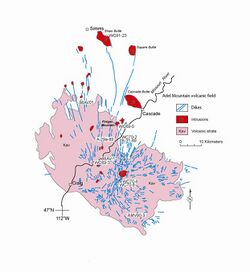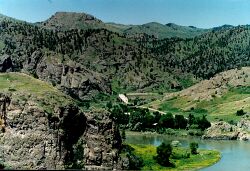Earth:Adel Mountains Volcanic Field
The Adel Mountains Volcanic Field (also known as the Adel Mountains, Adel Volcanics, and Adel Mountain Volcanics) is an ancient volcanic field of heavily eroded 75-million-year-old[1][2][3] igneous rocks about 40 miles long and 20 miles wide (800 square miles, or 2,071 square kilometers)[1][4][5] in west-central Montana about 30 miles southwest of the city of Great Falls. The area was named by geologist John Bartholomew Lyons,[6] who first described the general geology of the region in 1944.[7] The Adel Mountains Volcanic Field is a significant and abundant source of shonkinite, a very uncommon type of intrusive igneous rock found primarily in Montana, Ontario, and Timor.[1][2][8][9] Because of its geologic structure, the Adel Mountains Volcanic Field has drawn the attention of geologists for more than 100 years.[10]
Description
The Adel Mountains Volcanic Field is a 3,280-foot (1,000 m) thick unit which lies unconformably on top of Cretaceous sedimentary rock of the Two Medicine Formation on the edge of the Great Falls Tectonic Zone.[4][5][11] The extrusive rock is composed of breccia and conglomerate.[5] The intrusive rock has formed numerous dikes, sills, and plugs.[5] An "enormous number of dikes...emanate radially from its center",[12] many of which are visually striking and vertical, and can be seen from the interstate highway and other roads in the area.[1][5] Many of the dikes clearly fed laccoliths in the area.[5]
Two concentric rings of laccoliths lie in the northwest section of the field 11 miles (18 km) and 14 miles (23 km) from the center of the area.[1][5] Square Butte, Shaw Butte (near the town of Ft. Shaw), and Cascade Butte (next to the town of Cascade) are three laccoliths belonging to the Adel field which are famous local landmarks.[1][4][7] More than 2,000 feet (610 m) of rock which used to exist on top of Square Butte has subsequently eroded to reveal the igneous rock which forms the laccolith.[4]
Adel Mountain is the highest peak in the volcanic field, at 7,093 feet (2,162 m) above sea level, and an unnamed peak in the field is the second-highest at 6,845 feet (2,086 m) above sea level.[13]
Formation
The age of the Adel Mountain Volcanic Field has been re-estimated several times since 1944. Based on fossil evidence, Lyons estimated in 1944 that the formation was late Cretaceous in origin, making it about 66 million years old.[6] This estimate was reinforced in the early 1970s.[14] But a 1987 estimate based on new data put the age at early Tertiary, or about 60 million years old.[9] But separate analyses made in 1991 and 2004 re-estimated the rock as having formed in the late Cretaceous, about 81 to 71 million years ago.[5][10] Most estimates today place the age at 75 million years.[1][2][3] The Adel volcanics are part of the Laramide orogeny,[15] a period of mountain building in western North America which began about 80 million years ago and ended about 35 million years ago. The age of the volcanism and thrusting overlap, with some intrusions being affected by the thrusting while others were intruded into already formed thrust horses.[16][17]
Magma welled up from below for several million years, creating the Adel volcanics as well as the nearby Highwood Mountains and Judith Mountains.[1][4] The crustal weakness associated with the Great Falls Tectonic Zone may have provided a route for the magma to reach the surface.[4][5] Magma which never made it to the surface nonetheless created the many dikes, sills, plugs, and laccoliths which can be seen in the Adel volcanic field.[4][18]
Scientists have studied the Adel Mountains Volcanic Field for a number of reasons. Several teams of scientists have analyzed the polar wander path to study continental drift.[2][3] Others have looked at the possibility of petroleum or other hydrocarbons under the field, and concluded there is a strong possibility they exist there.[19]
Development of the area
Although not permanently inhabited by Native Americans, several tribes camped in the Adel Mountains Volcanic Field on their way to and from bison hunting rounds on the nearby plains (such as the pishkun, or buffalo jump, at nearby Ulm—the largest in the world).[4][20] The Lewis and Clark Expedition passed up the Missouri River through the area in July 1805, becoming the first white Americans to see the formations.[4]
Development of the area did not come until the 1930s. Cattle ranchers were the area's first white settlers.[4] The primary route over the Rocky Mountains to the Pacific Ocean, the Mullan Road, skirted the volcanic field to the north,[4] although dirt stagecoach roads were built into the Missouri River Canyon in the volcanic field in the 1860s.[21][22] The road was upgraded and turned into a toll road in 1866, and had become a major route from Helena through Great Falls to Fort Benton by the 1870s.[22] The Montana Central Railway reached the region in 1887, which led to additional white settlement.[4] A paved county road was laid down, and remained the sole access through the area for decades.[22] In the 1920s, the Montana Highway Department began planning a major highway through the area as part of their effort to build U.S. Highway 91 and provide a direct road connection between Helena and Great Falls.[4][21] Contracts were let in 1929, the majority of construction occurred from 1931 to 1934, and the highway was completed in 1935.[4][21] The Hardy Bridge, built over the Missouri River in 1931, was one of two major bridges built for Highway 91.[21] Interstate 15 was built largely on top of U.S. Highway 91 in 1967.[21][22]
In popular culture
The final scenes of the 1974 motion picture Thunderbolt and Lightfoot was filmed on and next to Interstate 15 as it passed through the Adel volcanics.[23] A portion of the 1987 movie The Untouchables was shot at the Hardy Bridge in the Adel Mountains Volcanic Field, which doubled for the U.S.-Canada border.[24]
Motion picture star Gary Cooper was raised on the Seven Bar Nine Ranch, which was located in the Adel Mountains.[25]
The eruption that formed the Adel Mountains Volcanic Field is depicted in the third episode of the American TV series Dinosaur Planet.[citation needed]
References
- ↑ 1.0 1.1 1.2 1.3 1.4 1.5 1.6 1.7 Merrill-Maker, Andrea. Montana Almanac. 2d ed. Guilford, Conn.: Globe Pequot, 2005. ISBN:0-7627-3655-0
- ↑ 2.0 2.1 2.2 2.3 Gunderson, Jay A. and Sheriff, Steven D. "A New Late Cretaceous Paleomagnetic Pole from the Adel Mountains, West Central Montana." Journal of Geophysical Research. 96:B1 (January 10, 1991).
- ↑ 3.0 3.1 3.2 Harlan, Stephen S.; Geissman, John W.; Snee, Lawrence W.; and Reynolds, Richard L. "Late Cretaceous Remagnetization of Proterozoic Mafic Dikes, Southern Highland Mountains, Southwestern Montana: A Paleomagnetic and 40Ar/39Ar Study." Geological Society of America Bulletin. 108:6 (June 1996).
- ↑ 4.00 4.01 4.02 4.03 4.04 4.05 4.06 4.07 4.08 4.09 4.10 4.11 4.12 4.13 "Cliffs High and Steep" - The Adel Mountain Volcanics. Montana Department of Transportation. No date. Accessed 2009-09-30.
- ↑ 5.0 5.1 5.2 5.3 5.4 5.5 5.6 5.7 5.8 Sheriff, Steven D. and Gunderson, Jay A. "Age of the Adel Mountain Volcanic Field, West-Central Montana." Isochron/West: A Bulletin of Isotopic Geochronology. December 1990.
- ↑ 6.0 6.1 Lyons, J.B. "Igneous Rocks of the Northern Big Belt Range, Montana." Geological Society of American Bulletin. 55:4 (April 1944).
- ↑ 7.0 7.1 Beall, Joseph J. "Pseudo-Rhythmic Layering in the Square Butte Alkali-Gabbro Laccolith." American Mineralogist. 57:7-8 (July–August 1972).
- ↑ Roberts, Eric M. and Hendrix, Marc S. "Taphonomy of a Petrified Forest in the Two Medicine Formation (Campanian), Northwest Montana: Implications for Palinspastic Restoration of the Boulder Batholith and Elkhorn Mountains Volcanics." Palaios. 15:5 (October 2000).
- ↑ 9.0 9.1 Hyndman, Donald W., and Alt, David. "Radial Dikes, Laccoliths and Gelatin Models." Journal of Geology. (1987).
- ↑ 10.0 10.1 Hearn, Jr., B. Carter. "The Homestead Kimberlite, Central Montana, USA: Mineralogy, Xenocrysts, and Upper-Mantle Xenoliths." In 8th International Kimberlite Conference: The J. Barry Hawthorn Volume. Vol. 2. T. Stachel, ed. Maryland Heights, Mo.: Gulf Professional Publishing, 2004. ISBN:0-444-51777-4
- ↑ Sears, James W.; Harms, Tekla A.; and Evenchick, C.A. Whence the Mountains?: Inquiries Into the Evolution of Orogenic Systems: A Volume in Honor of Raymond A. Price. Boulder, Colo.: Geological Society of America, 2007. ISBN:0-8137-2433-3
- ↑ Sheriff and Gunderson, "Age of the Adel Mountain Volcanic Field, West-Central Montana," Isochron/West: A Bulletin of Isotopic Geochronology, December 1990, p. 21.
- ↑ Daumiller, Gerry. "Montana's Tallest Peaks by Mountain Range." Natural Resource Information System. Montana State Library. Revised September 2007. Accessed 2009-09-30.
- ↑ Schmidt, Robert George. Geologic map of the Coburn Mountain quadrangle, Lewis and Clark and Cascade Counties, Montana. Quadrangle Map GQ-975. Washington, D.C.: U.S. Geological Survey, 1972.
- ↑ Burchfiel, B. Clark. "Tectonics of Noncollisional Regimes." In Continental Tectonics. Washington, D.C.: Geophysics Study Committee, Geophysics Research Board, Assembly of Mathematical and Physical Sciences, National Research Council, 1980. ISBN:0-309-02928-7
- ↑ Harlan, S.S., Snee, L.W., Reynolds, M. W., Mehnert, H.H., Schmidt, R.G., Sheriff, S.D. & Irving, A.J. 2005. 40Ar/39Ar and K-Ar Geochronology and Tectonic Significance of the Upper Cretaceous Adel Mountain Volcanics and Spatially Associated Tertiary Igneous Rocks, Northwestern Montana, USGS Professional Paper 1696
- ↑ Jolly, Arthur D. and Sheriff, Steven D. "Paleomagnetic Study of Thrust-Sheet Motion Along the Rocky Mountain Front in Montana." Geological Society of America Bulletin. June 1992.
- ↑ Topinka, Lyn. "America's Volcanic Past - Montana." Cascades Volcano Observatory, U.S. Geological Survey, June 11, 2003. Accessed 2009-10-01.
- ↑ Sears, James W.; Hansen, William B.; Ambrose, Rachele B.; Burtis, Erik W.; Hennes, Andrew M.; Hofmann, Michael H.; Laatsch, Nicholas A.; and Pallister, Beau J. "Montana's Triangle Zone." Rocky Mountain - 54th Annual Meeting of the Geological Society of America. May 7–9, 2002.
- ↑ The Ulm pishkun is the centerpiece of the First Peoples Buffalo Jump State Park in Montana, and the largest buffalo jump in the world. See: Conklin, Dave. Montana History Weekends: 52 Adventures in History. Guilford, Conn.: Globe Pequot, 2002. ISBN:0-7627-1161-2
- ↑ 21.0 21.1 21.2 21.3 21.4 Axline, Jon. Conveniences Sorely Needed: Montana's Historic Highway Bridges, 1860-1956. Helena, Mont.: Montana Historical Society, 2005. ISBN:0-9721522-6-1
- ↑ 22.0 22.1 22.2 22.3 Axline, Jon and Bradshaw, Glenda Clay. Montana's Historical Highway Markers. Rev. ed. Helena, Mont.: Montana Historical Society, 2008. ISBN:0-9759196-4-4
- ↑ Jim, Shirley Rose Higgins. "A Safe-Cracking Yarn Filmed in Montana." Chicago Tribune. May 26, 1974.
- ↑ Barth, Jack. Roadside Hollywood: The Movie Lover's State-By-State Guide to Film Locations, Celebrity Hangouts, Celluloid Tourist Attractions, and More. Chicago: Contemporary Books, 1991. ISBN:0-8092-4326-1
- ↑ Parish, James Robert; Stanke, Don E.; and Pitts, Michael R. The All-Americans. New York: Arlington House, 1977. ISBN:0-87000-363-1; Eastman, John. Who Lived Where: A Biographical Guide to Homes and Museums. New York: Facts on File Publications, 1985. ISBN:0-87196-562-3
External links
"Adel Mountain". Geographic Names Information System. United States Geological Survey. https://geonames.usgs.gov/apex/f?p=gnispq:3:::NO::P3_FID:1945918. Retrieved 2013-12-31.
[ ⚑ ] 47°04′34″N 111°42′24″W / 47.07606°N 111.70665°W




